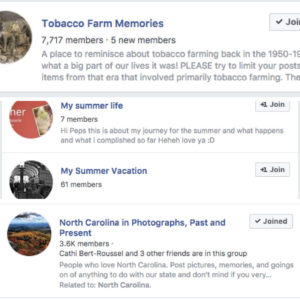1. Identify Your Audience Before You Start
Begin with this simple rule: Before you even choose a topic, determine at least five places you can share the content. Then, make sure those five places have a lot of potential readers. For example, if you want to write an article about cats, you may do a little preliminary research to find five “I Love Cats” groups on Facebook, each with over 50,000 active members. Cats would probably be a very good topic! Your topic should be specific, so you can easily determine the audience who would appreciate and engage with your content. Likewise, if you want to write about your favorite summer memory, you may discover the topic is too generic to find an audience. Many writers make the mistake of wanting to write about a topic that interests them, rather speaking to an audience and writing something for that group. So let’s assume you want to write about your favorite summer memories. How many Facebook groups will you find called “Summer Memories”? Probably not many. So let’s break that down a little further. What was your summer memory about? Was it a road trip? Was it staying at your Grandmother’s farm? Do a quick search. How many “Road Trip” groups are there? Or “Life on a Farm” groups? I bet there’s a lot more! But let’s go even further. Did you do a road trip or live on a farm in North Carolina? Do a quick scan for “North Carolina” groups. You’ll find a loyal and engaged following in several large Facebook groups. Let’s take a look: See the difference? Summer Vacation has a mere 61 members, while an impressive 7,717 people follow Tobacco Farm Life. North Carolina has 3,600 members, and there are many similar NC groups. Now, instead of just writing a general article about your summer memories, tailor that article to North Carolina, and then share it in the multitude of Carolina nostalgia groups. You have found your audience.2. Find Where Your Audience Lives
Before settling on a topic, I always do research on the groups where my audience lives. I may want to write about dinosaurs — but can I find enough dinosaur groups to ensure my article will have readers? One of my publication’s writers once wrote a beautiful article on his bittersweet childhood memories of the tragic Apollo mission. It was a well-crafted, poignant piece — and no one was reading it. Writers often believe that great writing equals lots of readers. Unfortunately, this is not always the case. In this instance, the author wrote a sentimental and moving article, but never shared it with his audience. How will anyone ever read it or share it if they never see it? I noticed the low readership and did a quick search for some space-related Facebook groups. I did basic keyword research: Space, Space and Universe, Space Exploration, Space Geeks. Within an hour, I had shared his article in several good-sized groups, each of which was full of people who would appreciate such an article. And guess what?The astronaut Buzz Aldrin sent our author a personal email, thanking him for the beautiful article.The moral of the story is this: Before you write an article, do some keyword research for related groups, message boards, magazines, Facebook pages, companies, or anyone else you think might be interested in reading and sharing your content. Then, write something that allows you, the writer, to genuinely connect with them, the reader.
3. Include Your Audience in the Process
Are you looking to write an article on the 5 Best Coffee Shops in Your City? Try asking your audience for their opinion! Include quotes and interviews from your audience, and they’ll begin to connect even more deeply with your content. Bonus: If you quote someone, they are more likely to share the article! Secondly, be sure to share your article with every coffee shop you include! Maybe your blog has 100 followers, but Coffeeland Latte Cafe has 5,000. Tag them and encourage them to share it! Local businesses love good reviews, they benefit from your publicity, and you benefit from their following. It’s a win-win. Here’s the killer combination: Join a very large and active group, find a topic they are passionate about, and make a post asking for opinions, memories, recipes, or stories. Then, write an article based on the answers the audience personally shares. Always be transparent about why you’re interviewing them. Once you’ve built up a good relationship with the group, group members are often happy to share their own stories and share the article their quote is published in.4. Write an Engaging Title
No matter how artsy the title “My Fairytale Mountain Adventure” may sound, you’re better off going with a title that explains a little bit about the contents of your article. Something more overt, like “Beauty and Danger: 5 Tales from My Month on the Appalachian Trail,” draws readers in by giving them a hint of what’s inside. A reader may not really be interested in the fairytale mountain adventure of a total stranger; however, a fellow hiker might be enticed to learn more about life on the Appalachian Trail, especially if they are planning a hike next month. While books and magazine articles often have more creative and artsy titles, the Internet is a fickle place. Your article is just a blip on someone’s timeline as they scroll down. You have to catch their attention fast, and the best way to do that is to be clear, concise, enticing, and relatable.5. Choose a Unique Featured Image
You have no idea how many blogs I see that don’t utilize powerful and unique featured images. Again, your post is just a blip speeding down someone’s timeline. A picture speaks a thousand words — so let your featured image tell your story before the audience even clicks on your article. Many businesses use stock images, or, worse, dull icons as a featured image. We all recognize stock photos on-sight, and the lack of effort and creativity decreases the incentive to click-through to the article. Here are the key things to look for in a strong, featured image:- Make it personal. Use one of your own photographs if you can. If you can’t, then find a historic, funny, or otherwise engaging photo online.
- Size it correctly. A pixilated, grainy, or poor-quality featured image will lose readers.
- Don’t use copyrighted images!
- Choose an image that tells a story.

6. Build Relationships; Get a Reputation
The golden rule of sharing into groups, forums, and Facebook pages: Add value; don’t spam. A lot of social sharing stems from building relationships. Don’t just join a group and share your own content over and over; instead, join these groups out of genuine interest for the topics, and be sure to interact with people. Share their posts. Leave comments. As you begin to build relationships, your content will add value to the group. For example, I often write about unique and hidden history in Raleigh. I began writing about it because it fascinated me, but I soon found several groups that appreciated my articles. Members shared interesting tidbits of history, and I gathered ideas for articles. Likewise, I shared my articles, and people were excited to see what I’d write about next. I began to get a reputation as both the person who always posts cool hidden history articles and a trusted resource. Likewise, I sought out other publications and artists who explore similar bits of weird history. I would share their content, comment on it, and get to know them. Reciprocally, they’d share my content. Over time, I built a network so strong it practically ensures any article on hidden history I write will have a strong kickstart of at least 10,000 readers to help it go viral.7. Do the Legwork
A lot of writers assume a good article will go viral all by itself. But every time I’ve had an article picked up by Huffington Post, Buzzfeed, UpWorthy, or any large publication — I contacted them. Don’t be afraid to put your article out there! As long as you provided good, quality content that adds value, a lot of places will be happy to share it.Here’s a checklist of legwork to do after your content is published:
- Share with related groups,
- Share with related pages,
- Tag related pages,
- Tag anyone who was interviewed,
- Send article to publications that may be interested in sharing — actually ask them to share, and
- Respond to all comments.
Other considerations:
- When sharing into a group or on a page, consider asking a question to engage comments and responses. For example: Here are my seven tips for helping content go viral. Do you have any tips to add?
- Good SEO is the gift that keeps on giving. If you can create content that has good SEO, traffic will continue flowing even after the initial virality dissipates.
- Most pieces of content go viral rapidly — or not at all. However, sometimes a piece of content will get shared by a follower months later and catch fire again. Quality content can provide backlinks and shares even years after it was published. Go back, refresh, and update old content!
And this checklist includes reciprocal acts to encourage a following:
- Interview and include readers in your article,
- Reach out to influencers in your field, and
- Share other people’s content, and they will share yours.

Leverage Viral Traffic
Once your article goes viral, be sure to leverage the influx of traffic. In fact, there’s another major set of strategies to implement in the event a piece of content does go viral. It’s the subject of Part Two of this blog: Steps to Take After Your Content Goes Viral. Now, these steps won’t guarantee your content will definitely go viral; but these are the best practices to encourage viral content. You don’t have to wait for luck and the whims of Internet chance to take your content to superstar status. Try these steps, and let us know how it goes!Create a Winning Content Strategy
Our digital marketing team has years of experience developing creative content, social media, and outreach strategies. Contact our content strategists and SEO professionals in Raleigh, NC at 919-341-8901 or schedule a complimentary consultation.
Tags: Digital Marketing • Inbound Marketing




